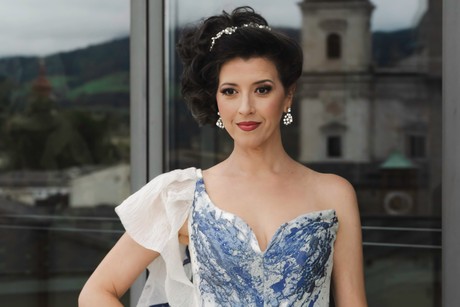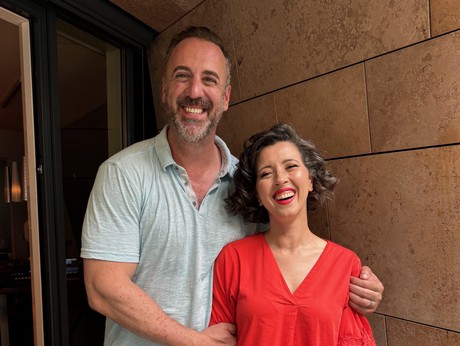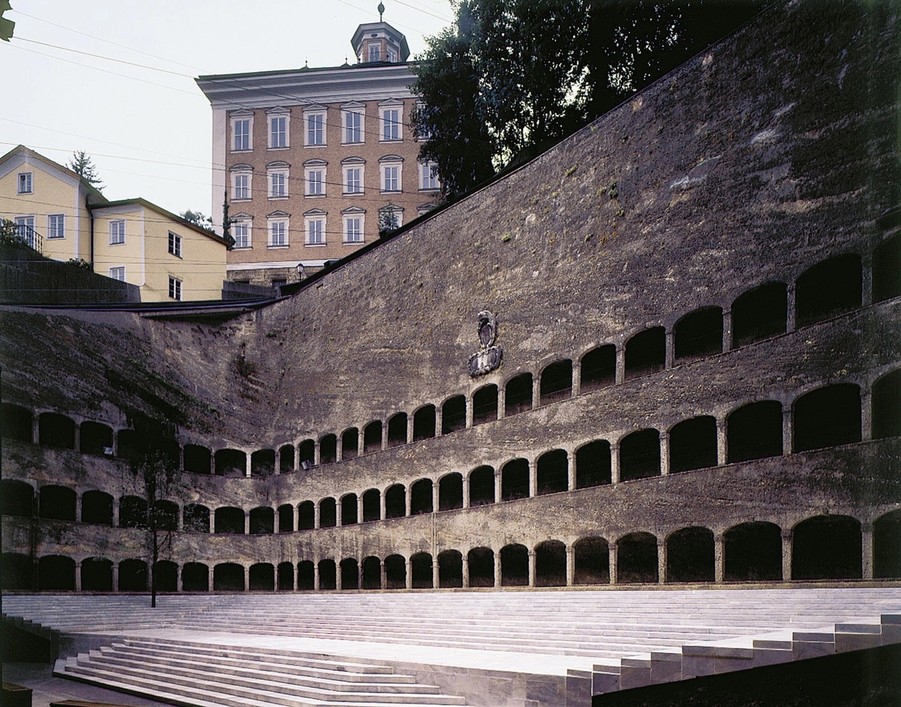Hamlet
Music by
Ambroise Thomas
Soloists
| Hamlet | Stéphane Degout | |
| Ophélie | Lisette Oropesa | |
| Claudius | Jean Teitgen | |
| Laërte | Julien Henric | |
| Ghost of the late King Hamlet | Clive Bayley | |
| Gertrude | Eve-Maud Hubeaux | |
| Polonius | Jerzy Butryn | |
| Horatio | Liam James Karai | |
| Marcellus | Raúl Gutiérrez | |
| Gravedigger | Ilya Silchuk | |
| Second Gravedigger | Seungwoo Simon Yang |
Conductor
Bertrand de Billy
ChorusmasterWalter Zeh
About
Opera in five acts (ca. 1860–1863/1867, premiered in 1868)
Libretto by Michel Carré and Jules Barbier after William Shakespeare’s tragedy
in the French adaptation by Alexandre Dumas père and Paul Meurice
Concert Performance
Philharmonia Chor Wien
Mozarteum Orchestra Salzburg
Media
Salzburg - Hamlet - 2024
Mad Scene - Hamlet - 2024

Austrian Music Theater Prize - Winner
Lisette wins Best Female Singer in the 2024 Austrian Music Theater Prize

Nominated for Best Female Singer in The Austrian Music Theatre Prize
Lisette is nominated for best female singer in The Austrian Music Theatre Prize

Christian Van Horn Podcast
Lisette is interviewed by Christian Van Horn on the CVH Podcast

2024 - Summer Newsletter
Welcome to my Summer 2024 Newsletter!
Reviews
Triumph der Grand Opéra
Königin des Abends: Lisette Oropesa Und eine überragt sie alle: die amerikanische Sopranistin Lisette Oropesa überflutet als Ophelia Orchester wie Ensembles mit ihrem glitzernden, berückend schönen Sopran, den sie mit atemverschlagender Perfektion in die höchsten Höhen führt. Beim ohrenbetäubenden Jubel nach ihrer Wahnsinnsarie fürchtet man kurz um die Statik des Hauses und um den Fortgang der Oper.Queen of the Evening: Lisette Oropesa And one outshines them all: the American soprano Lisette Oropesa, as Ophelia, floods the orchestra and ensembles with her sparkling, enchantingly beautiful soprano, which she carries with breathtaking perfection to the highest heights. During the deafening cheers following her mad scene aria, one briefly fears for the building's structural integrity and the continuation of the opera.— Michael Atzinger • BR Klassik
Konzertanter "Hamlet" in der Felsenreitschule: Der Dänenprinz auf Rachefeldzug
Die anspruchsvolle Rolle der Ophélie, die als Hamlets Braut unschuldig in dessen Rachepläne verwickelt wird und als "Verstoßene" im emotionalen Chaos Suizid begeht, liegt Lisette Oropesa gut. Von ihrer einsamen Wahnsinns-Szene mit Wechseln von Liebe zu Zweifeln und Verzweiflung, "À vos jeux, mes amis" als Höhepunkt der Oper konnte man nicht unberührt bleiben. Da hat man sich doch eine szenische Fassung herbeigewünscht, welche der hervorragenden Koloratursopranistin mehr Spielraum geboten hätte. Dennoch: das Publikum tobte.The demanding role of Ophelia, who, as Hamlet's bride, is innocently entangled in his plans for revenge and, as an "outcast," commits suicide in emotional chaos, suits Lisette Oropesa well. From her solitary madness scene with shifts from love to doubts and despair, "À vos jeux, mes amis" as the climax of the opera, one could not remain unaffected. There was indeed a desire for a scenic version that would have offered more space for the exceptional coloratura soprano. Nevertheless, the audience was ecstatic.— Ernst P. Strobl • Salzburger Nachrichten
Sein oder nicht sein? Wenn Oper zum musikalischen Thriller wird
Was Lisette Oropesa in dieser Partie leistet, ist fulminant. Virtuos perlen ihre Koloraturen. Das wie goldener Honig leuchtende Timbre ihres Soprans betört in den lyrischen Passagen. Da fehlt nichts. Ihre mit höchster Intensität vorgetragene Wahnszene versetzt das Publikum in Euphorie.What Lisette Oropesa delivers in this role is spectacular. Her coloraturas ripple virtuosically. The timbre of her soprano, glowing like golden honey, bewitches in the lyrical passages. Nothing is missing. Her mad scene, delivered with the highest intensity, sends the audience into euphoria.— Kurier.at • Kurier
Shakespeare als große Oper: Umjubelter „Hamlet“ in Salzburg
So wie auch, und ganz besonders, Lisette Oropesa. Wenn sie die Ophélie gibt, dann bleibt die Figur nicht bloß eine gläsern-zerbrechliche Femme fragile: Stattdessen erfüllt die Koloratursopranistin ihre einmal schlichten, dann wieder reich verzierten Kantilenen mit der Fülle und der Wärme einer Liebenden, die auf für sie unbegreifliche Weise enttäuscht wird und daraufhin in den Tod geht. Ein Hauch Cotrubas klingt da im Timbre an, eine Prise Gheorghiu – und doch ist Oropesa eine Diva eigenen Ranges, die ihre leuchtenden Spitzentöne in zartes Piano zurücknehmen kann: Das provozierte Jubelstürme schon nach ihrer Wahnsinnszene.Just as, and especially, Lisette Oropesa. When she assumes the role of Ophélie, the character is not merely a fragile, glass-like femme fragile: Instead, the coloratura soprano infuses her sometimes simple, sometimes richly ornamented cantilenas with the fullness and warmth of a lover who is incomprehensibly betrayed and subsequently succumbs to death. In her timbre, there's a hint of Cotrubas, a dash of Gheorghiu - and yet Oropesa is a diva of her own class, capable of modulating her luminous high notes into delicate piano: This provoked storms of applause already after her mad scene.— Walter Weidringer • Die Presse
Wo singen doch denken heißt
Anders als Soprane vom oft geschmähten Typus der „Ziersängerinnen“ hat die amerikanische Sopranistin Lisette Oropesa einen samtigen Sopran mit einem dunklen, matt-silbernen Timbre. Ophélies Klage über die erkaltete Liebe Hamlets – „Adieu dit-il, ayez foi“ – tauchte sie einen falb-fahlen, wie von einem matten Schleier umhüllten Klang von Schmerz und Trauer. In der Konfrontation mit Hamlet überzeugte sie durch dramatisches Agieren mit den Mitteln des verbalen Espressivo. Die zehn Minuten lange Szene, in der die in den Wahnsinn geflüchtete (oder getriebene) Ophélie von einer Wassernymphe singt, die Männer in den Tod lockt, gehört zu den berühmtesten Beispielen der Wahnsinns-Arie im 19. Jahrhundert. Welch expressive Spannung in dieser scheinbar dekorativen Musik verborgen ist, hat Maria Callas offenbart. Lisette Oropresa zeigte sich, ohne jede manieristische Anpassung, von ihr inspiriert. Sie führte ihre Stimme ebenso sicher durch Regionen, in denen die Stimme bis zum B und Cis gelangt, wie durch die ohne Zwitscherklänge verniedlichten Koloratur-Kaskaden des Walzer-Abschnitts.Unlike sopranos of the often maligned type of "ornament singers," the American soprano Lisette Oropesa has a velvety soprano with a dark, matte-silvery timbre. In Ophelia's lament over Hamlet's cooled love – "Adieu dit-il, ayez foi" – she enveloped a pallid, as if veiled by a dull sheen, sound of pain and sorrow. Confronting Hamlet, she convinced through dramatic acting with the means of verbal espressivo. The ten-minute scene where the mad (or driven) Ophelia sings of a water nymph who lures men to their death ranks among the most famous examples of the madness aria in the 19th century. The expressive tension hidden in this seemingly decorative music was revealed by Maria Callas. Lisette Oropresa, without any mannerist adaptation, showed herself inspired by her. She led her voice as confidently through regions where the voice reaches up to the B and C sharp, as through the without birdlike chirping sweetened coloratura cascades of the waltz section.— Jürgen Kesting • Frankfurter Allgemeine Zeitung
Was für ein Wahnsinn
„Aus allen Logen prasselten Blumensträuße und Kränze wie Hagel.“ Hätte das Publikum der Salzburger Festspiele die Blumendeko vom Abendessen mitgenommen, auch Lisette Oropesa wäre wohl unter Blumen begraben worden, statt als Ophelia ins Wasser zu gehen, wie es der zugrundeliegende Stoff von Shakespeares „Hamlet“ vorsieht. Mitten in der Wahnsinnsszene des vierten Akts beginnt man in der Felsenreitschule mit den Füßen zu trampeln, muss sich Oropesa verbeugen, der Dirigent Bertrand de Billy die Fortsetzung der Vorstellung schließlich erzwingen. Denn die Szene ist in der Tat irre, in den vokalen Anforderungen, die ihr Ambroise Thomas einkomponiert hat, nachdem sich Wahnsinn in der Oper gern in verrückten Koloraturen ausdrückt. Aber auch, weil Oropesa der Wahnsinn ist. Die Amerikanerin ist die momentan führende Sängerin im seltenen Fach des lyrischen Koloratursoprans. Was nichts anderes heißt, als dass sie einfach alles kann: Triller, Skalen, repetierte Spitzentöne von sensationeller Präzision – und dabei auch noch lyrisch klingen, herzwärmend, ergreifend. Faszinierend, wie weich ihre Höhen anfluten, noch faszinierender, wie sie die für die Uraufführungssängerin „nordisch“ angehauchte Ballade eindunkelt, ihr die schillernde Düsternis eines tiefen Sees gibt."Bouquets and wreaths rained down from every box." If the audience of the Salzburg Festival had taken the flower decorations from their dinner, Lisette Oropesa would probably have been buried under flowers instead of sinking into the water as Ophelia, as Shakespeare's "Hamlet" implies. In the middle of the insanity scene from the fourth act, the Felsenreitschule audience began to stomp their feet, forcing Oropesa to bow and conductor Bertrand de Billy to demand the continuation of the performance. Because the scene is indeed insane, in the vocal demands that Ambroise Thomas has composed into it, after madness in opera often expresses itself in crazy coloraturas. But also because Oropesa embodies madness. The American is currently the leading singer in the rare field of lyrical coloratura soprano. Which means nothing other than she can do everything: trills, scales, repeated top notes with sensational precision - and all while sounding lyrical, heartwarming, and moving. It's fascinating how softly her high notes flood in, even more fascinating how she infuses the "Nordic" tinged ballad intended for the premiere singer with the shimmering darkness of a deep lake.— Michael Stallknecht • Süddeutsche Zeitung
Salzburger Festspiele: „Hamlet“ – Eindrucksvolle konzertante Wiedergabe
Unglaublich, welche Koloratur-Akrobatik Lisette Oropesa im besten vokalen Sinne bei ihrer großen Arie im 2. Teil hören ließ! Das Publikum geriet aus dem Häuschen.It's incredible what vocal acrobatics Lisette Oropesa demonstrated in the best vocal sense during her major aria in the second part! The audience went wild.— Klaus Billand • Opern Magazin
Wahnsinnsfrau
Schon lang eine große Fangemeinde hat hier Lisette Oropesa, die nach ihrer umjubelten „Lucia di Lammermoor“ nun eine weitere legendäre Wahnsinnsszene der Opernliteratur gestalten darf. Und auch als Ophelia spart sie nicht mit perlenden Koloraturkaskaden und hell strahlenden Spitzentönen, die das Publikum in einen frenetischen Taumel versetzen und ihr bereits während der Aufführung nicht enden wollende Ovationen bescheren. Da gibt es keinen Kniff in der Diven-Trickkiste, den Oropesa nicht beherrscht. Und doch würde es zu kurz greifen, ihr Porträt allein auf effektvolle Stimmakrobatik zu reduzieren. Weil sie auch die emotionale Seite Ophelias nie aus den Augen verliert und deren jugendliche Schwärmerei ebenso glaubhaft spüren lässt wie die Verzweiflung in der Todesszene, die sie in zart gehauchte Piano-Phrasen hüllt.Lisette Oropesa, who has long garnered a large fan base here, is allowed to shape another legendary madness scene from the opera literature following her acclaimed performance in "Lucia di Lammermoor." As Ophelia, she does not hold back from delivering cascades of shimmering coloratura and brilliantly radiant high notes that plunge the audience into a frenetic frenzy, earning her endless ovations during the performance. There is no trick in the diva’s playbook that Oropesa doesn't master. Yet, to diminish her portrayal to mere sensational vocal acrobatics would be an understatement. She never loses sight of Ophelia's emotional depth, convincingly conveying the character’s youthful infatuation as well as the despair in the death scene, which she wraps in delicately whispered piano phrases.— Tobias Hell • OVB Heimatzeitungen
THOMAS, Hamlet – Salzbourg
Vrtuosité, légèreté, agilité, bien entendu, mais aussi couleurs dramatiques, endurance, et une grande facilité pour les vocalises, Lisette Oropesa possède tout cela et bien plus encore. Née et formée à la Nouvelle-Orléans en Louisiane, elle sera de retour à Paris dans les Puritains en janvier prochain. Son plaisir d’être en scène, très communicatif et stimulant pour ses partenaires, ajoute encore à sa popularité auprès du public, et c’est incontestablement elle qui, à la fin du spectacle, recueillera les plus spectaculaires faveurs de l’applaudimètre.Virtuosity, lightness, agility, of course, but also dramatic colors, stamina, and a great ease for vocalizations, Lisette Oropesa possesses all of this and much more. Born and trained in New Orleans, Louisiana, she will be returning to Paris for "The Puritans" next January. Her pleasure in being on stage, very contagious and stimulating for her partners, adds even more to her popularity with the audience, and undoubtedly, it is she who, at the end of the show, will gather the most spectacular favor of the applause meter.— Claude Jottrand • Forum Opera
An all-round triumph
Not surprisingly, Lisette Oropesa’s Ophélie has become one of her operatic calling cards in recent years, with numerous productions to her credit - including last year’s Paris Opera event, in which she starred opposite this evening’s Gertrude, Ève-Maud Hubeaux. The ideal combination of Oropesa’s limpid timbre, technical finesse, and a warmly-winning presence brought anticipated furore and a fully-deserved triumph for the soprano. In keeping with her Hamlet, Oropesa’s interpretation is wonderfully-balanced, moving from her opening Act 1 duet Doute de la lumière through Ophélie’s Act 2 lament, Sa main depuis hier n'a pas touché ma main! to a wonderfully-shaped Act 2 garden scene, Adieu, dit-il, ayez-foi! - and further rising to the great drama of Act 3’s trio with Hamlet and Gertrude. The celebrated mad sccene is a natural show-stealer, and Oropesa brought to it quite consummate stage work to compliment an ideal filigran sweep in vocal range and dynamics - deservedly crowning her evening with a thundering ovation from the house.None— Moore Parker • The Opera Critic
Salzburger Festspiele verhandeln die großen Fragen
Wenn eine Künstlerin herausgehoben werden sollte, wäre dies Lisette Oropesa als Ophélie: Nach ihren Arien gab es nicht nur tosenden Applaus und Bravos wie bei den anderen Sängern, bei ihr tobte die Felsenreitschule in einer ehrlich-ausgelassenen Begeisterung. Ihre lyrischen Koloraturen, die Flexibilität ihrer Stimme, die Schönheit des Klangs trotz der hohen musikalisch-gesanglichen Anforderungen – besonders in ihrer Wahnsinns-Arie im vierten Akt – berührten tief und waren unglaublich mitreißend.If one artist were to be singled out, it would be Lisette Oropesa as Ophélie: After her arias, there was not just thunderous applause and bravos as with the other singers, but the Felsenreitschule was abuzz with genuinely uninhibited enthusiasm. Her lyrical coloraturas, the flexibility of her voice, the beauty of its sound despite the high musical-vocal demands – especially in her mad scene aria in the fourth act – touched deeply and were incredibly captivating.— Brigitte Janoschka • Mittelbayerische
Hamlet konzertant
Die gesamte Aufführung war fulminant und lief durchweg auf höchstem Niveau ab. Musiker und Sänger im Chor und solistisch lieferten Hervorragendes ab. Wenn eine Künstlerin herausgehoben werden sollte, dann wäre dies Lisette Oropesa als Ophélie: Nach ihren Arien gab es nicht nur tosenden Applaus und Bravos, wie bei den anderen Sängern, bei ihr tobte die Felsenreitschule in einer ehrlich-ausgelassenen Begeisterung. Ihre lyrischen Koloraturen, die Flexibilität ihrer Stimme, die Schönheit des Klangs trotz der hohen musikalisch-gesanglichen Anforderungen – besonders in ihrer Wahnsinns-Arie im vierten Akt – berührten tief und waren unglaublich mitreißend. Da das Publikum nach einigen Minuten nicht mit seinen Beifallsbekundungen aufhören wollte, gab der Dirigent dem Chor das Zeichen zum neuen Einsatz und setzte die Aufführung mit dem fünften Akt fort. Nicht enden wollender Applaus auch zum Schluss.The entire performance was magnificent and consistently maintained the highest level. Musicians and singers in the chorus and as soloists delivered outstanding performances. If one artist should be singled out, it would be Lisette Oropesa as Ophélie: after her arias, there was not just thunderous applause and bravos, as with the other singers; the audience erupted in a genuinely exuberant enthusiasm for her. Her lyrical coloratura, the flexibility of her voice, the beauty of her tone despite the high musical and vocal demands - especially in her mad scene aria in the fourth act - deeply moved and were incredibly captivating. As the audience did not want to stop their applause after a few minutes, the conductor signaled the chorus for a new entrance and continued the performance with the fifth act. Applause that seemed endless also at the end.— Brigitte Janoschka • Berchtesgadener Anzeiger
Hamlet, jak má být. V Salcburku koncertně včetně jednoho ‚showstopperu‘
V koncertním provedení této opery triumfovala v loňském ročníku Salcburského festivalu americká sopranistka Lisette Oropesa. Lze se tedy divit, že letos si vedení letní přehlídky objednalo hvězdnou pěvkyni do další „šílené role“? Určitě ne. Oropesa ve svém pěveckém projevu dokonale spojuje hlasovou lehkost a ohebnost, skvělou techniku a schopnost přesvědčit posluchače, že dokáže pracovat s hlasovým rozsahem a dynamikou, jakkoliv se jí zamane. Sympatická pěvkyně evidentně dělala vše proto, aby v roli Ofélie působila jako disciplinovaná členka celkově velmi vyrovnaného ansáblu, ale málo platné, právě ona vždy dění na jevišti doslova rozsvítila. A její scéna šílenství „Et maintenant écoutez ma chanson … Le voilà! Je crois l´entendre“, kterou si vychutnala sice v koncertní róbě, ale pomuchlaná, rozcuchaná a bosá, to byl skutečný „showstopper“, po němž následoval několikaminutový nadšený aplaus publika. Není divu: tak brilantní kaskádu koloratur, za níž není jen smysl pro efekt, ale i pro drama a celkovou gradaci hudebního čísla, dnešní milovník belcanta opravdu často neslyší.In a concert performance of this opera last year, American soprano Lisette Oropesa triumphed at the Salzburg Festival. Is it any wonder then that the leadership of this year's summer showcase called for the star singer to play another "leading role"? Certainly not. Oropesa perfectly combines vocal lightness and elasticity in her singing expression, along with an incredible technique and a tendency to convince audiences that she can work with any vocal range or dynamics that come her way. The likable singer evidently did everything she could to portray Ophelia as a disciplined member of an overall very balanced ensemble. But inevitably, she is the one who always literally lights up the stage. And her scene featuring "Et maintenant écoutez ma chanson... Le voilà! Je crois l'entendre," which she enjoyed not only in her concert robe but disheveled, tousled, and barefoot, was a genuine "showstopper" followed by several minutes of enthusiastic applause from the audience. No wonder: listeners are not often treated to such a brilliant cascade of coloratura, for which the sense of effect and the drama and overall graduation of the musical number are not just about spectacle but also about love for bel canto.— Robert Rytina • Klasika Plus
Performance History
Lisette has given 14 performances as Ophélie.


